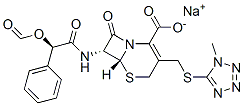|
ChemicalBook Optimization Suppliers |
|
| 化学名: | セファマンドールナファート | | 英語化学名: | Cemandil sodium salt | | 别名: | ,(6r-(6-alpha,7-beta(r)))-;Cemandil sodium salt;Sodium [6R-[6alpha,7beta(R*)]]-7-[[(formyloxy)phenylacetyl]amino]-3-[[(1-methyl-1H-tetrazol-5-yl)thio]methyl]-8-oxo-5-thia-1-azabicyclo[4.2.0]oct-2-ene-2-carboxylate;Cefamandole nafate,Cefamandole formate sodium salt;Cefamandole Nafate (250 mg);Cefamandole Nafate (200 mg);(6R,7R)-7-[[(2R)-2-(ForMyloxy)-2-phenylacetyl]aMino]-3-[[(1-Methyl-1H-tetrazol-5-yl)thio]Methyl]-8-oxo-5-thia-1-azabicyclo[4.2.0]oct-2-ene-2-carboxylic Acid SodiuM Salt;Bergacef | | CAS番号: | 42540-40-9 | | 分子式: | C19H17N6NaO6S2 | | 分子量: | 512.49 | | EINECS: | 255-877-4 | | カテゴリ情報: | MANDOL;Intermediates & Fine Chemicals;Pharmaceuticals | | Mol File: | 42540-40-9.mol |  |
| 融点 | 190-193°C | | 貯蔵温度 | Inert atmosphere,Store in freezer, under -20°C | | 溶解性 | Freely soluble in water, sparingly soluble in methanol. | | 酸解離定数(Pka) | 2.6-3.0(at 25℃) | | 色 | White to Off-White | | 水溶解度 | Freely soluble in water. Sparingly soluble in methanol | | CAS データベース | 42540-40-9(CAS DataBase Reference) |
| | セファマンドールナファート Usage And Synthesis |
| 効能 | 抗生物質, 細胞壁合成阻害薬 | | 化学的特性 | White Solid | | Originator | Mandokef,Lilly,W. Germany,1977 | | 使用 | Cephalosporin antibacterial. | | 使用 | A second generation cephalosporin antibiotic. | | 定義 | ChEBI: A cephalosporin prodrug having (R)-O-formylmandelamido and N-methylthiotetrazole side-groups. | | Manufacturing Process | To 21.6 kg (17.8 l) of 98% formic acid was added 1.14 kg (7.5 mols) of D-(-)-
mandelic acid and the reaction mixture was heated for 4 hours at 70°C with
stirring. The excess formic acid was evaporated off in vacuo and the residual
syrup was dissolved in 6 l of benzene. The solution was washed twice with 6 l
portions of water and was dried over magnesium sulfate. The drying agent
was filtered and washed with 1.5 l of benzene, the washes being added to the
filtrate. The dried filtrate was evaporated in vacuo to obtain the D-(-)-
mandelic acid formate ether as a syrup. The product can be crystallized from
cyclohexane to yield material melting at about 55°C to 58°C.
The mandelic acid formate ester obtained as a syrup as described above is
stirred for 2 hours with 2.9 kg (~1.75 l) of thionyl chloride at a temperature
of about 70°C. The excess thionyl chloride is removed by evaporation and the
residual green solution is vacuum distilled. The product, O-formyl mandeloyl
chloride, distills over at 127°C to 130°C (15 mm) or at 108°C to 112°C (7
mm).
To 13 l of ethyl acetate were added 85.1 g (2.59 mols) of 7-amino-3-(1-
methyl-1H-tetrazol-5-ylthiomethyl)-3-cephem-4-carboxylic acid and 1,361 g
(10.37 mols) of monotrimethylsilyl acetamide, and the mixture was stirred at
50°C until a clear solution was obtained. The solution was cooled to 20°C and
514 g (2.59 mold of O-formyl mandeloyl chloride was added at a rate such
that the temperature of the reaction solution was maintained between about
20°C to 25% with ice-cooling.
The reaction mixture was stirred for 1.5 hours at about room temperature
after the addition of the mandeloyl chloride was completed. Five liters of
water were then added to the reaction mixture and the diluted mixture was
stirred for about 10 minutes. The organic layer was separated and was
washed twice with water. The combined washes are extracted with 1.5 l of
ethyl acetate and the extract is combined with the washed organic layer. The
whole was dried over magnesium sulfate, filtered and evaporated in vacuo on
a 25°C water bath to yield 1,460 g of product, 7-(D-2-formyloxy-2-
phenylacetamido)-3-(1-methyl-1H-tetrazol-5-ylthiomethyl)-3-cephem-4-
carboxylic acid, as a yellow foam.
The product was dissolved in 5 l of acetone and the solution was mixed with a
solution of 430 g (2.59 mols) of sodium 2-ethylhexanoate in 5.4 l of acetone.
The combined solutions were seeded and stirred in an ice bath for 1.5 hours.
The crystalline precipitate of sodium 7-(D-2-formyloxy-2-phenylacetamido)-3-
(1-methyl-1H-tetrazol-5-ylthiomethyl)-3-cephem-4-carboxylate was filtered
and washed with 5 l of acetone. The crystalline salt was dried overnight in a
vacuum oven at 40°C to yield 1,060 g (80%)of product, melting at 182°C to
184°C. | | brand name | Mandol (Lilly). | | Therapeutic Function | Antibiotic | | 作用機序 | Cefamandole nafate has a formylated D-mandelic amide moiety at C-7. The formate ester is cleaved rapidly
in the host to release the more active cefamandole. The esterification also apparently overcomes the
instability of cefamandole when it is stored in dry form. This agent has increased activity against
Haemophil us influenzae and some Gram-negative bacilli as compared with the first-generation
cephalosporins. Loss of the 5-thio-l-methyl-l-H-tetrazole moiety (referred to sometimes by the acronym MT T)
from C-3 is associated with prothrombin deficiency and bleeding problems as well as with an Antabuse-like
acute alcohol intolerance. On the other hand, this grouping enhances potency and prevents metabolism by
deacetylation. Like the other second-generation cephalosporins, cefamandole is more active against
Gram-negative bacteria. The principle clinical use is for lower respiratory tract, skin and skin structures, and
bone and joint infections as well as septicemia and urinary tract infections when the organisms are sensitive. | | 臨床応用 | The D-mandeloyl moiety of Cemandil sodium salt appears toconfer resistance to a few β-lactamases, since some β-lactamase–producing, Gram-negative bacteria (particularlyEnterobacteriaceae) that show resistance to cefazolin andother first-generation cephalosporins are sensitive tocefamandole. Additionally, it is active against some ampicillin-resistant strains of Neisseria and Haemophilus spp.Although resistance to β-lactamases may be a factor in determiningthe sensitivity of individual bacterial strains tocefamandole, an early study indicated that other factors,such as permeability and intrinsic activity, are frequentlymore important. The L-mandeloyl isomer is significantlyless active than the D-isomer. |
|